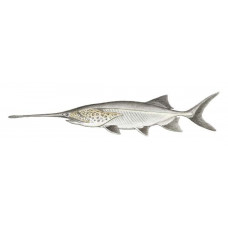Latin name
Polyodon spathula
Other names
Spoonbill, spoonbill catfish, spoonbill cat, American paddlefish, Mississippi paddlefish, shovel-billed cat, duckbilled cat, spadefish, shovelfish.
Identification
The paddlefish is almost sharklike in appearance, and if you cut off its long paddle-like snout, it looks even more like a shark. Unlike sharks and other fishes, the paddlefish has a unique, long, spade-like or spoon-shaped snout. The function of the snout is not well defined, although it is very long. It is thought that the fish uses the snout to locate prey, possibly by stirring up sediment on the bottom. There are two small barbs on the snout and the underside is dotted with sensory pits. Paddlefish also have a highly elongated operculum, an extremely large basket-like mouth, long gill wings, and a deeply forked tail with a high dorsal fin resembling a shark fin. Adults are toothless, but juveniles have teeth on their jaws. Coloration ranges from slate-gray to purple on top. The belly is almost white and the skin is smooth, with scales only on the caudal fins.
Distribution
American paddlefish are found throughout the Mississippi River basin, from the Missouri River in Montana southward. Some populations are self-sustaining, while others are supported by stocking. American paddlefish have been sent to Russia (50,000 eggs were shipped from Missouri in the mid-1970s) in an effort to stock the species there and increase egg production, which has suffered due to declining sturgeon populations.
Habitat
Paddlefish prefer low-gradient rivers, pools, backwaters, and estuaries. It also inhabits floodplain reservoirs as a result of dam construction. When not spawning, they are pelagic and can be found in open water.
Size
Paddlefish can live up to 25-30 years. They often grow to 100 pounds, although the average fish is much smaller. In the past, there have been reports of fish growing to over 200 pounds. The International Game Fish Association (IGFA) does not keep world records for this species, as they are caught on stumps rather than in the mouth. However, according to state records, a fish weighing 142 pounds, 8 ounces was caught in Montana's Missouri River in 1973. The 134-pound Missouri fish was over 20 years old.
Life history and Behavior
Adults migrate upstream to gravel bars in the spring and spawn in strong currents at 50-60°F. They are usually found in tailwater impoundments downstream of dams that prevent upstream migration. In rivers where they can move freely, paddlefish can migrate considerable distances. Spawning occurs in the middle of the stream and the sticky eggs attach to gravel on the bottom. After hatching, the fry move downstream on fast currents to deeper pools with slower water velocities. Where pools are found, they can serve as alternate spawning sites and important nursery areas for rapidly growing juveniles.
Food and feeding habits
Paddlefish feed on zooplankton, microscopic plants and animals in the open water. They swim through the water with their large open mouths and suck up zooplankton with their numerous (hundreds) of gill shells. They are not bottom feeders and move in shallow water or on the surface of slow moving currents with favorable feeding conditions.
Reproduction
No information
| Classification | |
| Phylum | Chordata |
| Class | Actinopterygii |
| Squad | Acipenseriformes |
| Family | Polyodontidae |
| Features | |
| Conservation status | No information |
| Habitat | Pelagic |
| Life span, years | 30 |
| Maximum body weight, kg | 500 |
| Maximum length, cm | 700 |
| Sailing speed, m/s | No information |
| Threat to people | No information |
| Way of eating | Planktonophage |
Paddlefish
Tags: Paddlefish



